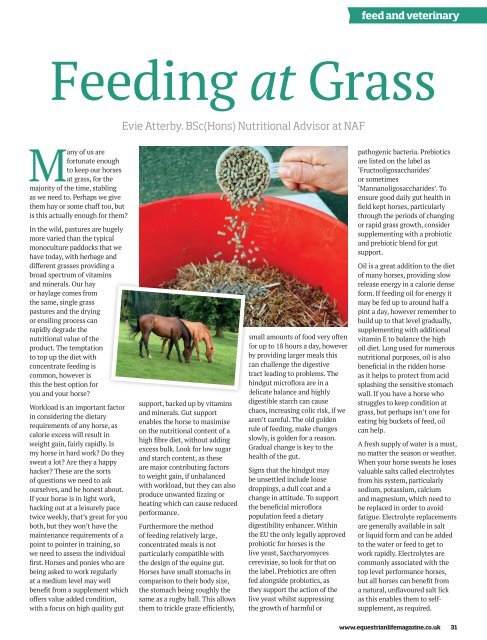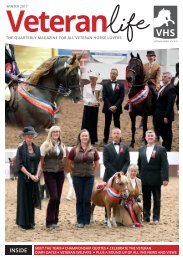Equestrian Life April 2018 Issue
Your leading monthly magazine for all horse lovers and riders
Your leading monthly magazine for all horse lovers and riders
Create successful ePaper yourself
Turn your PDF publications into a flip-book with our unique Google optimized e-Paper software.
feed and veterinary<br />
Feeding at Grass<br />
Evie Atterby. BSc(Hons) Nutritional Advisor at NAF<br />
Many of us are<br />
fortunate enough<br />
to keep our horses<br />
at grass, for the<br />
majority of the time, stabling<br />
as we need to. Perhaps we give<br />
them hay or some chaff too, but<br />
is this actually enough for them?<br />
In the wild, pastures are hugely<br />
more varied than the typical<br />
monoculture paddocks that we<br />
have today, with herbage and<br />
different grasses providing a<br />
broad spectrum of vitamins<br />
and minerals. Our hay<br />
or haylage comes from<br />
the same, single grass<br />
pastures and the drying<br />
or ensiling process can<br />
rapidly degrade the<br />
nutritional value of the<br />
product. The temptation<br />
to top up the diet with<br />
concentrate feeding is<br />
common, however is<br />
this the best option for<br />
you and your horse?<br />
Workload is an important factor<br />
in considering the dietary<br />
requirements of any horse, as<br />
calorie excess will result in<br />
weight gain, fairly rapidly. Is<br />
my horse in hard work? Do they<br />
sweat a lot? Are they a happy<br />
hacker? These are the sorts<br />
of questions we need to ask<br />
ourselves, and be honest about.<br />
If your horse is in light work,<br />
hacking out at a leisurely pace<br />
twice weekly, that’s great for you<br />
both, but they won’t have the<br />
maintenance requirements of a<br />
point to pointer in training, so<br />
we need to assess the individual<br />
first. Horses and ponies who are<br />
being asked to work regularly<br />
at a medium level may well<br />
benefit from a supplement which<br />
offers value added condition,<br />
with a focus on high quality gut<br />
support, backed up by vitamins<br />
and minerals. Gut support<br />
enables the horse to maximise<br />
on the nutritional content of a<br />
high fibre diet, without adding<br />
excess bulk. Look for low sugar<br />
and starch content, as these<br />
are major contributing factors<br />
to weight gain, if unbalanced<br />
with workload, but they can also<br />
produce unwanted fizzing or<br />
heating which can cause reduced<br />
performance.<br />
Furthermore the method<br />
of feeding relatively large,<br />
concentrated meals is not<br />
particularly compatible with<br />
the design of the equine gut.<br />
Horses have small stomachs in<br />
comparison to their body size,<br />
the stomach being roughly the<br />
same as a rugby ball. This allows<br />
them to trickle graze efficiently,<br />
small amounts of food very often<br />
for up to 18 hours a day, however<br />
by providing larger meals this<br />
can challenge the digestive<br />
tract leading to problems. The<br />
hindgut microflora are in a<br />
delicate balance and highly<br />
digestible starch can cause<br />
chaos, increasing colic risk, if we<br />
aren’t careful. The old golden<br />
rule of feeding, make changes<br />
slowly, is golden for a reason.<br />
Gradual change is key to the<br />
health of the gut.<br />
Signs that the hindgut may<br />
be unsettled include loose<br />
droppings, a dull coat and a<br />
change in attitude. To support<br />
the beneficial microflora<br />
population feed a dietary<br />
digestibility enhancer. Within<br />
the EU the only legally approved<br />
probiotic for horses is the<br />
live yeast, Saccharyomyces<br />
cerevisiae, so look for that on<br />
the label. Prebiotics are often<br />
fed alongside probiotics, as<br />
they support the action of the<br />
live yeast whilst suppressing<br />
the growth of harmful or<br />
pathogenic bacteria. Prebiotics<br />
are listed on the label as<br />
‘Fructooligosaccharides’<br />
or sometimes<br />
‘Mannanoligosaccharides’. To<br />
ensure good daily gut health in<br />
field kept horses, particularly<br />
through the periods of changing<br />
or rapid grass growth, consider<br />
supplementing with a probiotic<br />
and prebiotic blend for gut<br />
support.<br />
Oil is a great addition to the diet<br />
of many horses, providing slow<br />
release energy in a calorie dense<br />
form. If feeding oil for energy it<br />
may be fed up to around half a<br />
pint a day, however remember to<br />
build up to that level gradually,<br />
supplementing with additional<br />
vitamin E to balance the high<br />
oil diet. Long used for numerous<br />
nutritional purposes, oil is also<br />
beneficial in the ridden horse<br />
as it helps to protect from acid<br />
splashing the sensitive stomach<br />
wall. If you have a horse who<br />
struggles to keep condition at<br />
grass, but perhaps isn’t one for<br />
eating big buckets of feed, oil<br />
can help.<br />
A fresh supply of water is a must,<br />
no matter the season or weather.<br />
When your horse sweats he loses<br />
valuable salts called electrolytes<br />
from his system, particularly<br />
sodium, potassium, calcium<br />
and magnesium, which need to<br />
be replaced in order to avoid<br />
fatigue. Electrolyte replacements<br />
are generally available in salt<br />
or liquid form and can be added<br />
to the water or feed to get to<br />
work rapidly. Electrolytes are<br />
commonly associated with the<br />
top level performance horses,<br />
but all horses can benefit from<br />
a natural, unflavoured salt lick<br />
as this enables them to selfsupplement,<br />
as required.<br />
www.equestrianlifemagazine.co.uk 31
















